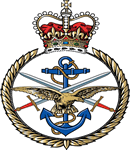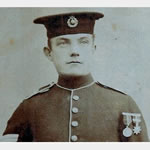Commemorated: | |||
| 1. Grave: | Poelcapelle British Cemetery | XVI. B. 18 | |
| 2. Book: | The (1921) Masonic Roll of Honour 1914-1918 | Pg.128 | |
| 3. Memorial: | The (1940) Scroll - WW1 Roll of Honour | 17D GQS | |
Awards & Titles: | Mentioned in Despatches British War Medal Victory Medal | ||
Early Life :
Born Aberdeenshire 14/11/1887.Married 29th December, 1910. Wife, Sarah, 16 Blake Rd., Gosport, Hants.
Service Life:
Campaigns:
- The First World War 1914-1918, World-wide.
- The Irish Uprising 1916, Ireland.
| Unit / Ship / Est.: 2nd R.M. Bn. Royal Marine Light Infantry |
| Action : France & Flanders |
France & Flanders covers all the dates and corresponding locations which are outside the official battle nomenclature dates on the Western Front. Therefore the actions in which these men died could be considered 'normal' trench duty - the daily attrition losses which were an everyday fact of duty on the Western Front.
Detail :
Acting Captain Peter Ligertwood, Royal Marines Light Infantry. Killed in Action 26th October, 1917.
ex PO/14301 Sergeant RMLI.
Enlisted Aberdeen 22nd January, 1906. Promoted: Corporal 2nd July, 1910, Sergeant 20th September, 1914. Commissioned Lieutenant RM 18th January, 1916 and promoted Acting Captain 22nd October, 1917 just days before his death. Served with the Portsmouth Division (at Deal) 5/12/1912-17/1/16. Served in Ireland 26/4/16-14/5/16. Draft for B.E.F. 27/4/17, joined 1st RM Battalion 16/5/17, transferred to 2nd RM Battalion 17/5/17-5/7/17 to hospital (sick), rejoined 2nd RM Battalion 11/9/17-26/10/17.
He was mentioned in the Despatches of of Sir Douglas Haig dated 7th November, 1917 - London Gazette 27/2/18 p.2585.
From the Royal Marines Divisional History: "One of the finest exploits of this second stage of the attack was the crossing of the Paddebeek by Captain Ligertwood's company of the 2nd Marines. The platoons of this company had gone into action under their own flags, strips of red canvas nailed to a stick cut from the woods where the company had done their training, solemnly blessed by the Battalion Chaplain, Father Davey, and taken into action with honour and reverence. These flags were carried through the battle. Captain Ligertwood, three times wounded, led his company to within sight of their goal, when he fell mortally wounded, to rise only once to direct his men to their objective. But on this front and at this time success was denied even to the bravest. This company, staying on their objective throughout the entire day, were powerless to lift a finger to assist the main battle still being fought on the first objective where the enemy centre held their ground.".
From 'Britain's Sea Soldiers' by Gen Sir H. E. Blumberg [page 334]: "The orders for the 2/RMLI stated that passing through the 1/RMLI they were to attack with two companies in front, "A" on the right and "C" on the left, "B" Company in reserve and "D" company carrying; the frontage allotted was 800 yards; their greatest strength was to be opposite the concreted positions at V.28a.9.9. No one was to cross to the north side of the Lekkerboterbeek stream, but the left company was to cover that area with Lewis gun fire. ... ... ...The Battalion was directed to assemble on a line 150 yards east of Burns House - Vacher Farm Road. At 6-30 am they were to pass through 1/RMLI and form for attack behind the stationary barrage at the limit of the first objective, and move forward with the barrage at 7-36 am.
"A" and "C" companies were to drop parties to consolidate as they went forward. The Battalion duly passed though 1/RMLI but it was only on the flanks that they were able to make any headway; "A" Company gallantly led by Lieut. P. Ligertwood, who had connected his men together with spun yarn to prevent their leaving the narrow tracks through the mud, crossed the Paddebeek and made good his position there. He provided each platoon with a small red flag, which in the absence of regimental colours, had been blessed by the Battalion chaplain, and these were carried forward and served as rallying points for the platoons; three of these flags now rest at the Chatham, Portsmouth and Plymouth Divisions, the bearer of the fourth was killed and it was lost in the Flanders mud. Lieutenant (acting Captain) Ligertwood, although three times wounded, maintained his position, but when wounded for the fourth time and compelled to go to the rear, he pointed out the further objective and ordered his men to go forward; this very gallant officer died of his wounds. [footnote - Lieutenant Ligertwood, who was one of the crack shots of the Corps, was commissioned in 1916, and had proved himself a most valuable and gallant officer.]" Credits to "horatio2" and "michaeldr" from the Great War Forum.
Masonic :
| Type | Lodge Name and No. | Province/District : |
|---|---|---|
| Mother : | Lord Warden No. 1096 E.C. | East Kent |
Initiated | Passed | Raised |
5th October 1915 | 5th November 1915 | 3rd December 1915 |
Peter is recorded in the 1921 Book and the 1940 Scroll as "LIGHTERWOOD", but closer inspection of the contribution records shows his name as LIGERTWOOD, which then allows research to continue and proving his real name. he was initiated into Lord Warden Lodge, Deal, Kent in 1915 as a 27 year old sergeant in the Royal Marines Light Infantry. The record shows his war service but it is short lived by the final comment: "Killed in Action 1918."
Source :
The project globally acknowledges the following as sources of information for research across the whole database:
- The Commonwealth War Graves Commission
- The (UK) National Archives
- Ancestry.co.uk - Genealogy, Family Trees & Family History online
- ugle.org.uk - The records of the United Grand Lodge of England including the Library and Museum of Freemasonry
Additional Source:
- Founder Researchers : Paul Masters & Mike McCarthy
- Researcher : Bruce Littley

